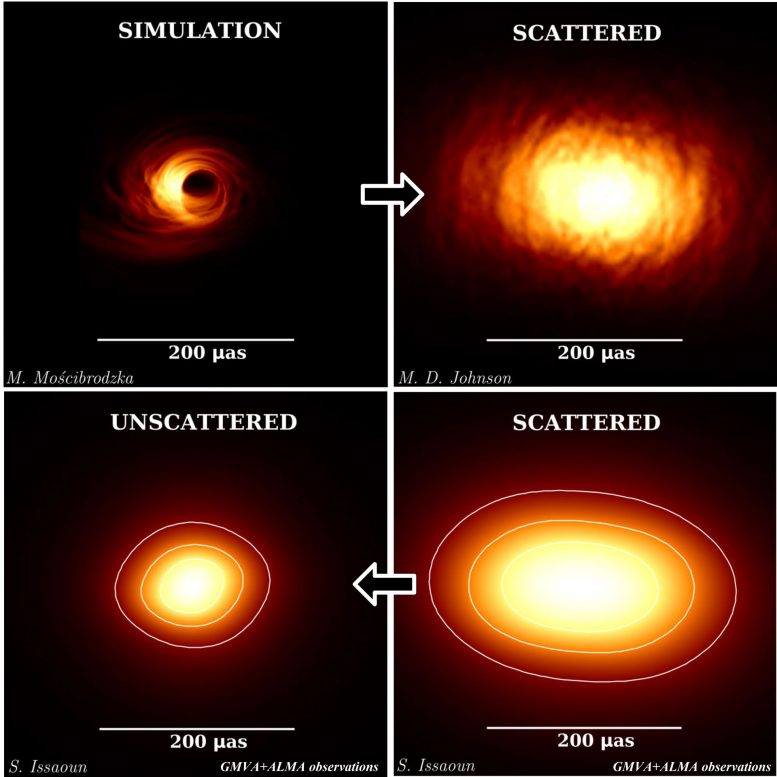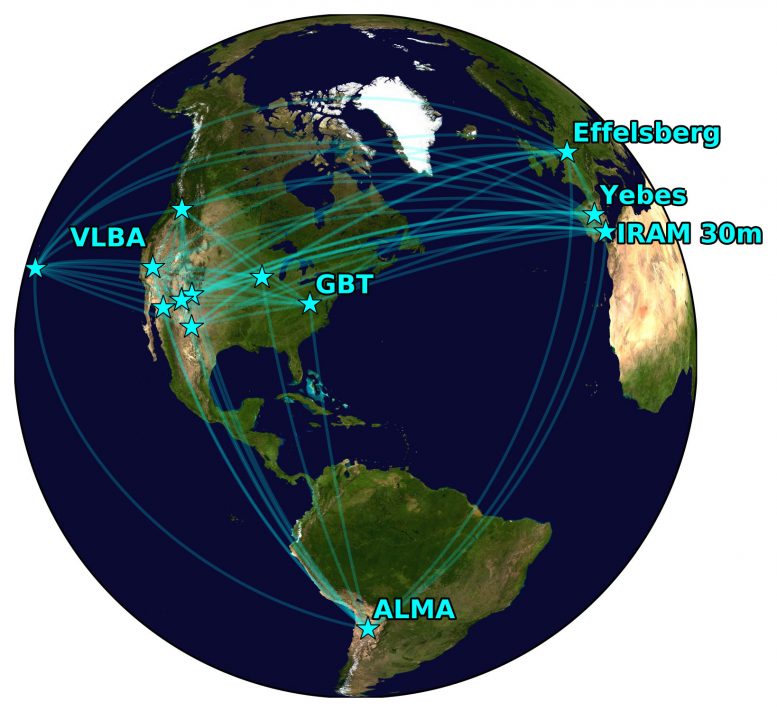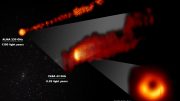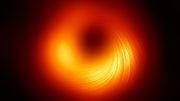
Top left: simulation of Sgr A* at 86 GHz without interstellar scattering. Top right: simulation with interstellar scattering. Bottom right: observed image of Sgr A*. Bottom left: observed image of Sgr A* after removing the effects of interstellar scattering. Credit: S. Issaoun, M. Mościbrodzka, Radboud University/ M. D. Johnson, CfA
A black hole four million times as massive as our Sun lurks at the center of the Milky Way. This black hole, called Sagittarius A* (Sgr A*), swallows nearby material that glows brightly as it approaches the event horizon. This galactic furnace is key to understanding black holes, but our view of it is obscured by lumpy clouds of electrons throughout the Galaxy. These clouds stretch, blur, and crinkle the image of Sgr A*, making it appear as though the black hole is blocked by an enormous sheet of frosted glass.
Now, a team of astronomers, led by Radboud University Ph.D. student Sara Issaoun, have finally been able to see through these clouds and study what makes the black hole glow. Issaoun completed this work while participating in the Predoctoral Program at the Smithsonian Astrophysical Observatory in Cambridge, MA.
“The source of the radiation from Sgr A* has been debated for decades,” says Michael Johnson of the Center for Astrophysics Harvard and Smithsonian (CfA). “Some models predict that the radiation comes from the disk of material being swallowed by the black hole, while others attribute it to a jet of material shooting away from the black hole. Without a sharper view of the black hole, we can’t exclude either possibility.”
The team used the technique of Very Long Baseline Interferometry (VLBI), which combines many telescopes to form a virtual telescope the size of the Earth. The decisive advance was equipping the powerful ALMA array of telescopes in northern Chile with a new phasing system. This allowed it to join the GMVA, a global network of twelve other telescopes in North America and Europe.

The Global Millimeter VLBI Array, joined by ALMA. Credit: S. Issaoun, Radboud University/ D. Pesce, CfA
“ALMA itself is a collection of more than 50 radio dishes. The magic of the new ALMA Phasing System is to allow all these dishes to function as a single telescope, which has the sensitivity of a single dish more than 75 meters across. That sensitivity, and its location high in the Andes mountains, makes it perfect for this Sgr A* study,” says Shep Doeleman of the CfA, who was the Principal Investigator of the ALMA Phasing Project.
“The breakthrough in image quality came from two factors,” explains Lindy Blackburn, a radio astronomer at the CfA. “By observing at high frequencies, the image corruption from interstellar material was less significant, and by adding ALMA, we doubled the resolving power of our instrument.”
The new images show that the radiation from Sgr A* has a symmetrical morphology and is smaller than expected – it spans a mere 300 millionth of a degree. “This may indicate that the radio emission is produced in a disk of infalling gas rather than by a radio jet,” explains Issaoun, who tested computer simulations against the images. “However, that would make Sgr A* an exception compared to other radio-emitting black holes. The alternative could be that the radio jet is pointing almost directly at us.”
Issaoun’s supervisor Heino Falcke, Professor of Radio Astronomy at Radboud University, was surprised by this result. Last year, Falcke would have considered this new jet model implausible, but recently another set of researchers came to a similar conclusion using ESO’s Very Large Telescope Interferometer of optical telescopes and an independent technique. “Maybe this is true after all,” concludes Falcke, “and we are looking at this beast from a very special vantage point.”
To learn more will require pushing these telescopes to even higher frequencies. “The first observations of Sgr A* at 86 GHz date from 26 years ago, with only a handful of telescopes. Over the years, the quality of the data has improved steadily as more telescopes join,” says J. Anton Zensus, director of the Max Planck Institute for Radio Astronomy.
Michael Johnson is optimistic. “If ALMA has the same success in joining the Event Horizon Telescope at even higher frequencies, then these new results show that interstellar scattering will not stop us from peering all the way down to the event horizon of the black hole.”
Reference: “The Size, Shape, and Scattering of Sagittarius A* at 86 GHz: First VLBI with ALMA” by S. Issaoun, M. D. Johnson, L. Blackburn, C. D. Brinkerink, M. Moscibrodzka, A. Chael, C. Goddi, I. Martí-Vidal, J. Wagner, S. S. Doeleman, H. Falcke, T. P. Krichbaum, K. Akiyama, U. Bach, K. L. Bouman, G. C. Bower, A. Broderick, I. Cho, G. Crew, J. Dexter, V. Fish, R. Gold, J. L. Gómez, K. Hada, A. Hernández-Gómez, M. Janßen, M. Kino, M. Kramer, L. Loinard, R.-S. Lu, S. Markoff, D. P. Marrone, L. D. Matthews, J. M. Moran, C. Müller, F. Roelofs, E. Ros, H. Rottmann, S. Sanchez, R. P. J. Tilanus, P. de Vicente, M. Wielgus, J. A. Zensus and G.-Y. Zhao, 21 January 2019, The Astrophysical Journal.
DOI: 10.3847/1538-4357/aaf732








I do not see any black hole there but only a light emitting Body.
No Event horizon, no accretion disc. In the Picture it Looks perfectly like a very big star or gas cloud with stars inside.
Let’s wait for the next Pictures at higher freq.
Am I dyslexic? I thought that a higher frequency penetrates less into a scattering medium than low frequency energy…How does raising the frequency of a telescope array yield a reduction of the effects of scattering? It seems counter-intuitive to me…shouldn’t they have lowered the frequency as low as possible to maximize penetration of a scattering medium?
It seems like they are accumulating more data with this approach, sure, but how are they defeating scattering? Not in an analog, reality-based manner, but a digital imaginary one? In other words, are we simply embedding ourselves deeper into dependency on computer models, using the same approach as 26 years ago, but just with more data and better computers? Are we even considering mitigating scattering in a mechanical way, or just planning to edit it out with sophisticated photoshop? To me, the transverse nature of electro-magnetic waves is challenged by scattering (Thanks, Dollard). Otherwise, it’s all just an effort to glom more and more data, as if this was some sort of agenda in itself (New World Order?). Mitigate the scattering effect by the generation of more scattering because it amounts to more data and all we need is more data to feed to our computers and they will tell us how it is. Do expect to solve all our problems in the future this way? Everyone start littering so the robots have something to do so we can advance our robots to the point where they can actually clean up the planet. The solution to trash is trash plus computers!
Maybe I’m missing something here, but I have a feeling not everyone understands this as well as HAL…
Would be nice to hear back.